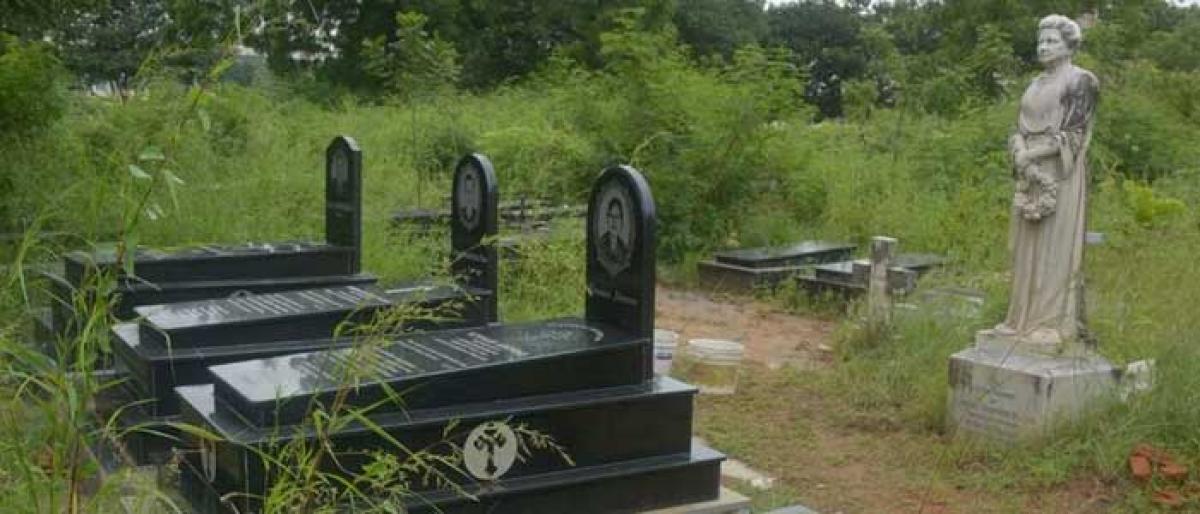Live
- BJP urges EC to stop Cong’s ‘Guarantee Cards’ campaign aimed to 'induce voters'
- Congress cheated Madigas: Dr. RS Praveen Kumar
- CBDT signs record 125 pacts to ease tax payments by big multinational firms
- Kamal Nath accuses BJP of ‘threatening’ Congress leaders in Chhindwara
- Odisha: BJP, BJD allege violation of MCC
- PM Modi lands in Guwahati to kickstart poll campaign
- ‘100 day action plan’ is PM Modi’s signature style for setting goals and meeting targets
- BJP will change the Constitution if they come to power again, says Priyanka Gandhi
- BJP-led NDA to cross 390-mark in Lok Sabha polls, predicts India TV-CNX survey
- Haier launches new TV series in four sizes in India
Just In

The relics of the British Raj with graves in shapes of massive pyramids, memorial plaques and epitaphs reflect Secunderabad’s rich colonial heritage. The commonwealth graves, as they came to be known, are open air history books.
Secunderabad: The relics of the British Raj with graves in shapes of massive pyramids, memorial plaques and epitaphs reflect Secunderabad’s rich colonial heritage. The commonwealth graves, as they came to be known, are open air history books.
The inscriptions, decorations and epitaphs on gravestones give us a glimpse into the days of yore. Men, women and children of British descent who were stationed at Secunderabad were buried here and so often, people from England come to the churches in the cantonment in search of their ancestors. After 1947, British graves were handed over to various churches under Church of South India, CSI Medak Diocese and ever since, respective churches have been maintaining the graveyards.
There are four major British or commonwealth graveyards in the Secunderabad cantonment, two at Trimulgherry, one at Sainikpuri and another adjacent to Parade Grounds. Presbyter Wesley of St John’s Church cemetery says, “People from different parts of the world, especially from England, keep coming here tracing their roots. Some of the graves date back to 200 plus years.”
These graveyards are sprawling in 5-6 acres and the graveyards in Trimulgherry are spread over 13 acres each. The respective churches get Rs 1,500 each per year for the maintenance of these cemeteries from the Commonwealth War Graves Commission (CWGC) which is insufficient, say authorities.
These relics of the Raj are not just tokens of sad remembrance but also treasure trove of history. Some of the inscriptions reflect the way people thought, respected and treasured their loved ones, friends and officers. For instance, the monument, the biggest at the Parade Grounds cemetery that of Lt Col James Dalrymple, who died at a young age of 44 who commanded the East India Company forces and served the Nizam, was erected by the officers who served under his command and by the officers of British Residency. Interestingly, the inscription is written both in English and Urdu. He died in 1800.
Some statues in the graveyards made of marble date back to over hundred years and are still standing amid blades of grass. Some of the inscriptions are short and sweet, while a few border on humour as well. Some officers died very young and were buried here, for example, George William Bowness, Lieutenant in 7th Regiment Light Cavalry Madras Army who died on October 5, 1818. The inscription reads: His death is deeply and deservedly lamented by his numerous friends and relations.
Many British soldiers and children died in 1848, many between the ages 20 to 35. Raj, 70, a resident of Sainikpuri says, “Medical facilities were poor and jungle fever and plague was common.”
Authorities of various churches say that these graveyards have a huge potential to attract tourists especially from England. “We get queries regularly and many eventually come down to trace the graves of their relatives,” they say.

© 2024 Hyderabad Media House Limited/The Hans India. All rights reserved. Powered by hocalwire.com







